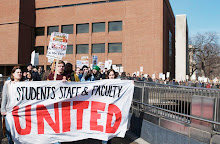Faculty, including P&A, who would like to sign the letter may do so at:
http://www.petitiononline.com/frpeumn/petition.html
***
To: Robert Bruininks, President, University of Minnesota
Open Letter to President Bruininks
from the Faculty for the Renewal of Public Education
We are dismayed at the inequity and short-sightedness of your plan to address financial stringency by imposing temporary reductions in employee compensation. Moreover, we deplore your threat that if the Faculty Senate does not approve your plan to cut faculty compensation, “deeper college- and unit-level cuts, which will inevitably lead to additional job losses,” will be made (e-mail message to faculty, March 16, 2010). There are better ways to reduce expenditures at the University, and better models for salary reductions than what you have proposed.
Faculty are willing to accept reductions in compensation sufficient in magnitude to protect the lowest-paid employees at the University from suffering any cuts at all, provided that the plan is equitable rather than regressive, and that expenditures bearing the least relation to the University’s mission are cut first. Because it is faculty alone who have the privilege to vote on whether to accept a reduction in compensation, it is incumbent on faculty to demand that such cuts be equitable and that they be proposed in accord with applicable University policy.
Your proposal calls for the following compensation reductions: a three-day mandatory furlough for all civil service and union-represented staff; a uniform reduction of 1.15% in the compensation of all faculty; and a uniform reduction of 2.3% in the compensation of academic and administrative officers (numbering 85 positions total). Contrast the cuts made in 1932, when the University and the nation faced a comparable situation of economic duress. At that time, the Regents imposed a salary cut on a sliding scale, reducing all salaries above a certain threshold in graduated increments while leaving salaries below that threshold untouched. We quote the University News Release of May 1932 on this matter:
The regents put into effect a slash of 20 percent on that part of any salary over $3600; of 15 percent on that part between $2400 and $3600; of 10 percent on that part between $1100 and $2400, but left without reduction salaries and wages up to and including the figure $1200 [sic] a year.
In our view this should provide the model for reductions in compensation now. A similar sliding-scale cut would easily achieve greater savings than the $18.5 million that your plan would yield.
Any cut to faculty and staff compensation, however, should only be considered in the context of a long-term plan for dealing with the budgetary crisis, after cutting expenditures that are not essential to the University’s primary missions of education, research, and public service. Faculty should be provided full access to all available budgetary information, be apprised of the measures under consideration to reduce the budget, and have the opportunity to propose alternative reductions. These principles are embodied in the Regents’ Policy on Faculty Tenure, which accords faculty a participatory role in determining how best to address any financial crisis. Instead, the administration merely informs faculty of cuts in state appropriations, and provides only piecemeal information on how the University is spending the funds at its disposal. The administration has not sought broad faculty participation in determining what to cut; when staff or faculty point out excess spending to reduce, we are ignored.
Instead of demanding only that faculty vote to approve whatever your administration proposes, invite us to contribute to identifying where cuts could be made with no harm to the academic mission. Here are a few suggestions.
➢ Driven to Discover – What does this branding scheme cost? What good does it do for instruction, research, or the citizens of Minnesota?
➢ Wellness Initiative – While programs that help employees improve their health may be valuable in principle, it makes no sense to continue producing abundant glossy advertising for this initiative, and paying employees $65.00 each time they participate in it, at the same time that the administration keeps on raising the tuition students pay.
➢ UMore Park – Millions of dollars have been invested in the proposed development of “a sustainable community of 20,000-30,000 people” at this site on the suburban fringe. Although UMore Park does host some research projects, funding a speculative real estate development can hardly be justified as part of the University’s core mission.
If the University is truly in a situation of financial stringency, programs like these should see funding cuts before academic programs do.
Reductions in state funding have worsened our present situation. But poor planning and misplaced priorities are also to blame. Next year’s state appropriation is close to that of 2007. During the last two years, a hiring pause and salary freeze have been in effect, while academic units have suffered successive cuts and numerous staff have been laid off. Given these cost-cutting measures, with prudent administration, the University’s operating costs should not have increased so dramatically as to make a return to 2007 funding levels catastrophic. Moreover, the present budgetary shortfall cannot be described as unforeseeable. According to your March 16 e-mail message, the shortfall consists of the following three components: (1) increased annual costs, including a proposed 2% raise (44%); (2) the 27th pay period, a calendrical artifact of the bi-weekly payroll system (31%); and (3) the governor’s proposed budget cut through unallotment (25%). The first and second components were not merely foreseeable; in the case of the raise (which many faculty oppose), they are planned. Only the amount of the governor’s unallotment was unforeseen. University workers should not be made to pay the price of the administration’s poor planning.
As faculty, we are responsible for carrying out the University’s teaching and research missions, and we accordingly share responsibility for University governance. We repeat that we are willing to accept compensation reductions, should they be necessary, as part of a coherent strategy to rectify the University’s financial situation. We do not accept your administration’s proposal to impose uniform pay cuts, forcing the lowest-paid employees to bear the burden of financial stringency, while failing to reduce expenditures that do not contribute to the fulfillment of our core mission.
Wednesday, March 24, 2010
Subscribe to:
Post Comments (Atom)


No comments:
Post a Comment